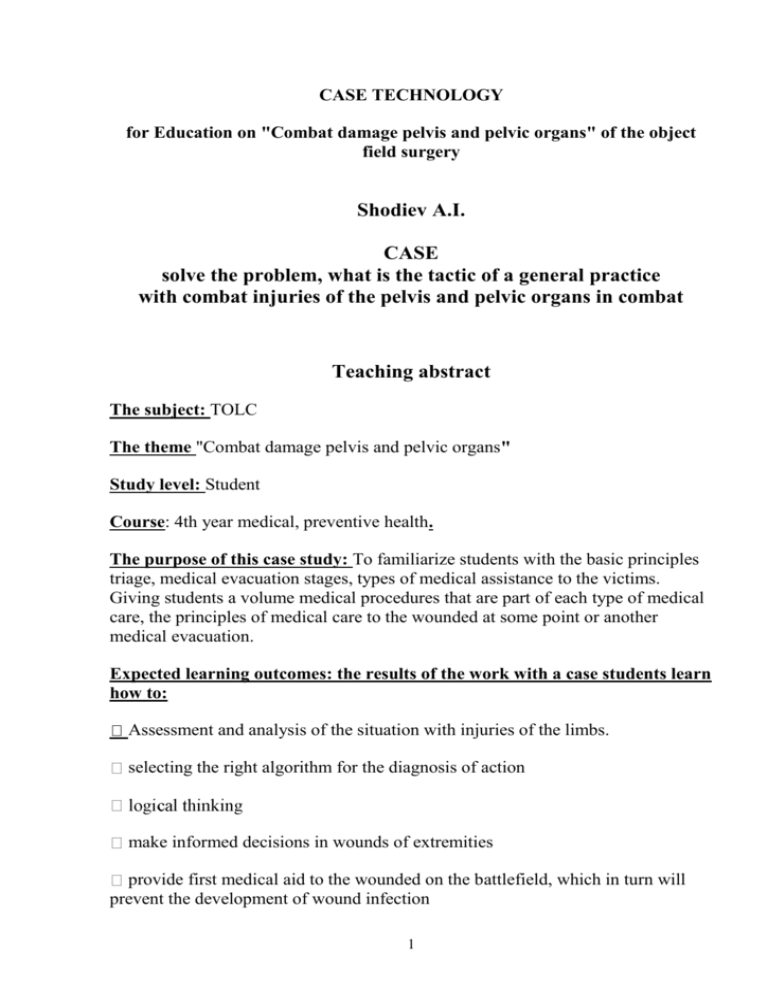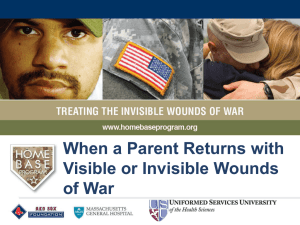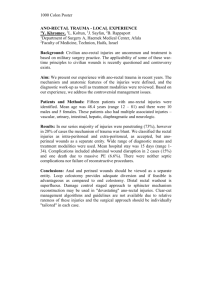wounds hepatic
advertisement

CASE TECHNOLOGY for Education on "Combat damage pelvis and pelvic organs" of the object field surgery Shodiev A.I. CASE solve the problem, what is the tactic of a general practice with combat injuries of the pelvis and pelvic organs in combat Teaching abstract The subject: TOLC The theme "Combat damage pelvis and pelvic organs" Study level: Student Course: 4th year medical, preventive health. The purpose of this case study: To familiarize students with the basic principles triage, medical evacuation stages, types of medical assistance to the victims. Giving students a volume medical procedures that are part of each type of medical care, the principles of medical care to the wounded at some point or another medical evacuation. Expected learning outcomes: the results of the work with a case students learn how to: Assessment and analysis of the situation with injuries of the limbs. selecting the right algorithm for the diagnosis of action make informed decisions in wounds of extremities provide first medical aid to the wounded on the battlefield, which in turn will prevent the development of wound infection 1 medical care at the stages of medical evacuation For the successful resolution of the case study student should know • define limb injuries; • define the concept of a wound; • Basic principles of triage to the wounded limb at a particular stage of medical evacuation; • problem of medical evacuations from combat wounds of the extremities; • the types of care for the wounded; • The volume of the main activities provided wounded every form of medical care. This case reflects the real situation in primary care Sources of information case: 1. Yumashev GS "Traumatology and Orthopaedics" Moscow, "Medicine" in 1990. - 575s. 2. Musalatov HA "Traumatology and Orthopaedics", Moscow, "Medicine" in 1995. -c. 3. V. Maslov "Practical lessons in military surgery" Saratov in 1988 with 220 4. "Notes on military surgery" V.N.Byalin, L.N.Bisenkov, P.G.Bryusov etc. M. 2000. - 415s. 5. WWW.ejbjs.org WWW.jbjs org.uk WWW.traumatic.ru WWW.trauma.bd.ru Characteristics of case study according to typological features. This case is classified as a desk, scene. It is short, structured. This casequestion task. For didactic purposes Case Training, stimulating thinking in the real world in a hovercraft and GWP. Case can be used in the disciplines: War-surgery, emergency condition 2 Introduction "Combat damage pelvis and pelvic organs" Classification 1. Open neognestrelnye gunshot injuries: - Non-penetrating wounds without damaging the internal organs; - Penetrating injury with damage of parenchymal organs, hollow organs, hollow and solid organ, retroperitoneal organs, spine; - Thoraco-abdominal injuries. 2. Closed injuries of the abdomen: - Bruising of the abdominal wall; - Closed hollow organ damage; - Closed solid organ injury; - Closed damage hollow and solid organ; - Closed kidney damage. In modern warfare, we should expect a significant severe wounds and closed injuries of the abdomen. Increase the number of closed injuries, combine-• whined. multiple and combined injuries. Especially difficult will flow "ball" injury multiplicity; most diverse localization of ports (often on the back), one-time heavy damage to various organs due to sudden changes of direction the ball, more extensive ruptures organs, increasing the number of thoraco-abdominal injuries. Difficulties to diagnose injuries represent swept elements - low profile inlets as yes the abdominal wall and the abdominal organs. DIAGNOSIS closed injuries BELLY Damage to the hollow organs - pain at rest and try n-.. tspai.chi, dry tongue, rapid pulse, wooden belly, lack of motility, lack of hepatic dullness, with X-rays - gas below the diaphragm or in the sides of at lateroposition Solid organ damage - symptoms of blood loss, symptoms of fluid accumulation in the abdominal cavity. Closed injuries of the kidneys - hematuria, blurred contours podvzyushno-psoas hematoma on radiographs because necessarily performed intravenous urography to avoid wicking contrast in perirenal fat (then shown lumbotomy). Closed injuries of the pancreas - retroperitoneal hematoma, pain encircles the upper part of the stomach, increased diastase. Closed injuries of the retroperitoneal part of a duodenum-pain in the upper abdomen and in the lumbar region, the emerging signs of retroperitoneal phlegmon may be signs of high intestinal obstruction. DIAGNOSIS OF OPEN ABDOMINAL INJURY Absolute signs of penetrating wounds 1. loss of bowel or omentum; 2. discharge from the wound feces, bile, urine; 3. symptoms of peritonitis. The essential features of penetrating wounds: 3 dry tongue, rapid pulse, delayed stool and gas, lack of peristalsis, muscular defense, positive signs of peritoneal irritation, loss of hepatic dullness, shortening of percussion sound in the sloping ground. SPECIAL DIAGNOSTIC TECHNIQUES - Comparison of the input and output of wounds in Exit Wounds; - Finger study rectum (blood indicates penetrating injuries to the colon); - Determination of the loss of blood; - X-ray; - Celiocentesis; - Diagnostic laparotomy (minilaparotomy in critically ill patients with multiple injuries, when you need to reliably exclude bleeding in the stomach or damage to the hollow organs of the abdomen); - The dynamic observation TREATMENT FOR stages of medical evacuation of wounded from battle damage BELLY Battlefield, BMP: - Bandages large immobilization (fallen bodies do not reduce a); - Analgesics; - Quick takeaway. First medical aid (WFP): For the wounded of the first group - the state average weight: fixing bandages, antibiotics and tetanus toxoid, with clear evidence of penetrating wound morphine, the primary evacuation HMO. The second group - wounded in serious condition to prepare for evacuation should be performed: procaine blockade (perirenal, vagosympathetic inside pelvic), pour intravenously polyglukin, enter the heart, analgesics. Skilled surgical care (HMO) The faster operated wounded with penetrating wound to the abdomen, the greater the chances of a favorable outcome. Triage: The first group - the wounded with symptoms continuing abdominal bleeding, wounded with obvious signs of damage to the hollow organs - immediate surgery. Vtooaya group - with no clear signs of internal bleeding, but in the "shock II-III degree. Patients requiring dynamic monitoring - operation indications in 1-2 hours. The third group - inoperable wounded - after antishock therapy pressure does not rise - conservative treatment in the hospital ward. The fourth group - may be towed: bruising of the abdominal wall, in the GLR, kidney-bruising .v Urological Hospital, non-penetrating wounds without damaging the organs of the abdomen in general. Surgical Hospital. Laparotomy in HMO C features): - Under general anesthesia; - Only midline laparotomy; - The search for the source of bleeding and stop bleeding; 4 - Full audit of the abdominal cavity (opening bruising under visceral peritoneum, the revision of the stomach wall Okay, finding pairs of wounds on hollow organs); - Stitching wounds colon, stomach, small bowel resection with anastomosis "side to side> resection of the colon leading to excretion and removing bowel into the wound of the abdominal wall (shotgun), suturing wounds of the rectum with imposing unnatural anus: - Laundering and drying of the abdomen; - The introduction of novocaine into the root of the small intestine (may be mikroirrigator); - Drainage of the subphrenic space left after the removal of the spleen, right, after mending the wounds of the liver (the drainage in this case is derived from posterior-axillary line), lateral drainage channels and pelvis through an incision in the iliac region after operations on hollow organs: - Laparotomic suturing wounds; - Stretching the anus (under anesthesia); - Suturing the stomach into the sheets. Evacuation contraindicated 7-12 days. Postoperative complications In 2/3 of all the operated. Mortality from the experience of the Great Patriotic War - | 50% after laparotomy 10%. Complications early - shock, intestinal paresis, peritonitis. Complications later - festering wounds eventeratsiya (10%), pneumonia (25%), fistulas, adhesive disease, ventral herniaSpecialized surgery: (Hospitals for the wounded in the chest, abdomen, pelvis) shameful operations and treatment of peritonitis, abscesses limited opening of the abdominal cavity, and closure treatment of intestinal fistula, recovery operations on the gastro-intestinal tract. COMBAT Open pelvic injuries (gunshot), - Soft tissue injuries.;. - Wounds of soft tissue and bone; - Wounds of soft tissue and bone for internal injuries - injuries intraperitoneal bladder and rectum damage extraperitoneal bladder and rectum. Closed fractures: edge, pelvic ring fractures without broken, broken in violation of the integrity of the pelvic ring (the front half rings, half rings back, vertical, diagonal). Breaks the pubic joint, breaks the sacroiliac joint. Diagnosis of closed fractures of the pelvis: - Palpation of the pelvic ring; - Palpation of the pelvis through the rectum in women - through the vagina; - A symptom of "sticky heel> fracture front half rings. In fractures of the pelvis always do finger study rectal and urine output (if he can not help). Signs of intraperitoneal bladder injury: can not urinate during catheterization or no urine can be a lot at once, cystography. 5 Primakov extraperitoneal bladder injuries: can not urinate, urinary catheterization in small, it bloody, and over time can be uroplania crotch, thighs, scrotum, cystography. Signs of damage perineum urethra: can not urinate, blood in the external opening of the urethra, a catheter (rezinovyy!) does not pass into the bladder, the bladder may be full, cystography! Symptoms of rectal injury in closed fracture of the pelvic bones, blood vials in the rectum, recent signs of pelvic cellulitis. Diagnosis of open pelvic injuries: - Examination of the wound, to determine the direction of the wound channel - Palpation - diagnosis of fracture; - Finger study rectum (fractures, pelvic inflammation of the peritoneum - the pain); - Diagnosis vnebryushnnnyh direct bowel injury, degeneration of feces and gas from the wound, palpation of bone fragments and blood in the rectum; - Diagnosis of intraperitoneal rectal injury: signs of peritonitis; - Diagnosis of intraperitoneal bladder injuries; lack of urine catheterization or her very much, signs accumulation of fluid in the abdominal cavity; - Diagnosis of bladder lesions vnebryushichnyh: outflow of urine sludge wound. absence of urination, blood in the catheter. Cystography. Staged treatment of the wounded from the battle damage PELVIS Stage of first aid (self-help, mutual aid, aid medical orderly, paramedic BMP): - Bandage on the wound; - Transportation of the shield with the roller under your knees; - Analgesics of syringe-tube. stage of the first medical aid (WFP): - Correction of dressings; - Puncture of the bladder; - Stop the bleeding (tamponade wound suturing the skin over it!) - Treatment of severe shock; - The introduction of antibiotics; - The introduction of tetanus toxoid; - Transportation of the shield with the roller under your knees. Step qualified surgical assistance: Sort: - Wounded with ongoing bleeding; - The victim in a state of shock; - Wounded on intra-and extraperitoneal rectal injury and bladder, but no signs of shock, - Wounded with closed and open pelvic injuries. with internal organs intact perineum is damaged, the bony part of the urethra and genitalia; - Bruises and superficial-v. soft tissue wounds; - Moribund. Surgery for gunshot wounds of the pelvis - pchssechenie wound excision of nonviable tissue, removal of foreign bodies and bone fragments 6 svobodnolezhashih, stop bleeding (n possible ligation of the internal iliac artery), drainage of the wound. If the damage of the rectum - certainly imposed unnatural anus. Intraperitoneal bladder injury-laparotomy. suturing wounds bladder DIL hub catgut suture, the imposition suprapubic fistula, draining the bladder through the urethra with a rubber catheter. Intraperitoneal rectal injuries - laparoscopic ¬ tomy, revision of the abdominal cavity, suturing wounds of the rectum, imposing unnatural anus, abdominal drainage, suturing wounds of the abdominal wall. When vnebryushnnnyh injuries bladder - extraperitoneal exposure of the bladder, suturing wounds front or side wall (if possible), drain fat okolopuzyrnoy on Buyal'skiy, imposing nadlobko ¬ Vågå fistula with the introduction of a catheter into the bladder type Peltzer. With injuries perineal urethra - the imposition of suprapubic fistula drainage okolopuzyrnoy fiber on Buyal'skiy, the introduction of a rubber bladder catheter. Primary suture and plastic urethral gunshot wounds are not shown. Stage specialized surgical care: - Clarification of the nature of injury (X-ray, urography, urethra-cystography, cystoscopy); - Treatment of ascending infection of the urinary tract; - Opening and drainage streaks, phlegmon, abscess, the treatment of osteomyelitis of the pelvis; - Plastic urethral scar its structure; - Closure of the suprapubic fistula, unnatural anus; - Treatment confusions pelvis special techniques (skeletal traction, reposition hammock, etc.) II. Methodical instructions student Problem: The determination of the cause of poisoning and development of measures to address the toxic effects. Instructions for independent work in the analysis and solution of practical situations. Stages Recommendations and advice 1. Familiarization first check with case with case Reading, Do not try to analyze the situation 2. Acquaintance again, read the information, select the paragraphs that seemed with a given important to you. 7 situation Try to describe the situation. Determine that it is important and what is secondary. Problem: Selecting tactics wounded prevention and treatment of wound infections in phases honey. evacuation.. 3. Identification, formulation and justification of the key issues and subproblems 4. Diagnostic In the analysis of the situation, answer the following analysis of the questions:: situation basic principles of triage, stages of medical evacuation, the types of care for victims The volume of medical procedures that are part of each type of care; principles of medical care to the wounded at some stage of medical evacuation 5. Selection and List all the possible ways to solve this problem in a given justification of the situation methods and means of addressing 6. Development Put diagnosis, determine how to solve the problem in a GWP and resolution of and AEP the problem situation Instructions for group work to analyze and solve practical situation. Stages Recommendations and advice Reconciliation of the situation Discuss and agree on different views of and the problem. members on the situation, the problem of the subproblems. Analysis and evaluation of the Discuss and evaluate the proposed options and proposed methods and means of ways to address the problem. Select the solving problems, the choice of priority, in your opinion, the idea of solving priority the idea to solve the the problem. problem. Develop mutually acceptable Develop a mutually acceptable solution to the solution to the problem and problem and the detailed design detailed design implementation. implementation. 1. Clearly and accurately describe the cause of the poisoning; 8 Prepare a presentation 2. Justify prescribing have chosen to treat poisoning. Make the results in the form of an oral presentation on behalf of the group. Discuss and decide the question of who will represent the results of the group work: the leader of the whole group, or with the division between the participants (co-reports), depending on the tasks to be solved by them in the course of analyzing and solving problems. Prepare illustrative materials in the form of posters, slides or multimedia. In the preparation of reports, especially mark the rough outline of what you say, do not go into the details! Table assessment of individual work with case Participants evaluation criteria and indicators Detailed Анализ Selecting development текущей Justification ways and of measures ситуаци problem means of to implement и max max 0,5 addressing the decision 1,0 max 0,5 max 0,5 Overall Score (Max 2,5) * 1. 2. № * 2.0 - 2.5 points - "excellent", 1.5 - 2.0 points - the "good" 1.0 - 1.5 points - "satisfactory" less than 1.0 points - "unsatisfactory" The evaluation system options group decision problem. 1. Each group is given two evaluation points. It can give them all at once to one embodiment of the decision or split into two (1:1 0,5:1,5, etc.), not including the assessment of their own solutions. 2. All the scores for each alternative solutions are added. The winner is the solution with the highest number of points. In disputed cases, you can take a vote. 9 Table evaluate options group decision problem, the score Group Alternative solutions to the problem 1 2 3 № 1. 2. № Sum Score presentation of the proposed solution Group Complete ness and clarity of presentati on (1 – 20) visibility of representa tion of the universe of presentati on (1 – 20) mass susceptib ility and activity of members of the group (1 – 20) Originalit y proposed decision (1 – 20) the admissibility of the legislative (1 – 20) standard s (1 - 20) total score (max 100) 1. 2. № III. OPTION ACTION CASEY Teachers - KEYSOLOGOM 1. Symptoms listed above indicate that the victim through a clear bullet wound in the left forearm. 2. The tactics of a general practitioner: A quick assessment of the state of the wounded to determine the severity of infection. B.Zavedite hemodynamic monitoring list (time, pressure, pulse, respiratory rate, temperature, blood loss are approximate) B. Application of tourniquet and aseptic dressings, antibiotics 3. Tactics of the doctor at the stage of qualified and specialized honey. assistance: Surgical treatment, depending on the length and type of wound infection. When the need for reconstructive types of operations IV. Case Study Technology for practical training. 10 Model of learning technologies Subject Hours – 2 Form of lesson combat damage limbs Number of students: 10 people Exercise increase knowledge, development of skills tactics wounded in phases honey Practical lesson plan 1. Introduction to the training session 2. Actualization of knowledge 3. Work with a case of mini - groups 4. Presentation of the results 5. Execution skills 6. Discussion, evaluation and selection of the best option strategies 7. Conclusion. Evaluation of the groups and students, the degree of achievement of lesson The purpose of the training session: expanded knowledge of the tactics of the wounded on the steps honey. evacuation. Developing the ability to assess, analyze the situation, the choice of tactics, diagnosis, emergency care, efficient transport of wounded at the primary level. Tasks the teacher: Результаты учебной деятельности: • consolidate and deepen the • оценивают и анализируют knowledge to assess and analyze the ситуацию и общее состояние situation and the general condition of раненых на этапах мед. the wounded at the stages of honey. эвакуации evacuation • выбирают алгоритм действий • Develop the ability to select the для постановки диагноза. correct algorithm of actions for • развивают навык diagnosis. самостоятельного принятия • Develop skills to provide emergency решения при ведении раненых assistance на этапах мед. эвакуации • To develop the skills of independent • вырабатывают алгоритм decision-making in the management of действий оказаний экстренной the wounded on the steps honey. помощи при необходимости evacuation of learning outcomes: • assess and analyze the situation and the general condition of the wounded on the steps honey. evacuation • Select action algorithm for diagnosis. • develop skills of independent decision-making in the management of the wounded on the steps honey. evacuation • produce a sequence of actions for 11 emergency assistance if required Methods of teaching case studies, discussion, practical method, organizers Learning Tools Learning forms Case, guidance Individual Study mode, front, group work Learning conditions audience with technical equipment, work in groups Monitoring and Evaluation Monitoring, blitz poll vzaimootsenka, evaluation presentation Flow chart of lesson and Д activity Teachers Explain the purpose of the preparatory stage of case - the stage and its influence on the development of professional knowledge. Distributes materials case and introduces the algorithm for analysis of the situation (see Guidelines for students). Gives the task independently analyze and record the results in the "List of analysis of the situation 1.1. Thread class is called, the plan, its I stage. goals, objectives and expected learning Introduction to the training outcomes. 1.2. Introduces the mode of operation for session employment and evaluation criteria (see the (10-15 instructions for students) minutes) Stage content Phase II core 60 min 2.1. Justifies the statement of the problem and the choice of the situation - relevance. Conducting a poll in order to enhance students' knowledge on the topic: • Stages of medical evacuation • The volume of medical care at the stages of honey. evacuation 2.2. Divides students into groups. Reminiscent of the content and objectives of the case. Introduces (like) the rules of the group and the rules of the debate. 12 Students Listen Independently examine the contents of an individual case and fill the sheet of the situation. Listen Are appropriate records Are divided into groups Discuss, conduct a joint analysis of individual problems, determine the most important aspects of the situation, the main problems and their solutions, process, results of the decision 2.3. Gives the task, specify the correct perception of the task: • What nosologies to make a differential diagnosis • Diagnostic methods used in SVP and GWP • Further tactics GPs with injuries 2.4. Coordinates, advises, directs the learning activities. Evaluates the results of individual work: Sheets of the situation. 2.5. Of the presentation on the results of the work done to address the case study, discussion. Organizer of the discussion: ask questions, remarks, recalled the theoretical material 2.6. Organizer - GP algorithm of actions in a given situation 2.7. Tells own solution case study to answer questions, discuss, ask clarifying questions. III Summary of 3.1. Summarizes the results of training studies, activities, announces a joint evaluation of analysis and individual work. evaluation 20 Analyzes and evaluates the group, notes the min positive and negative points. 3.2. Stresses the importance of case - the stage and its impact on the future specialist listen. 13 Present options to address issues 10-15 minutes after the end of the presentation, choose the best option Develop a unified system, the discussion Can a self-assessment Opine






